History of Stratocaster
- Before Stratocaster
- Pre-CBS Years
- 1954 Fender Stratocaster: The Birth of an Icon
- 1955 Fender Stratocaster
- 1956 Fender Stratocaster
- 1957 Fender Stratocaster
- 1958 Fender Stratocaster
- 1959 Fender Stratocaster
- 1960 Fender Stratocaster
- 1961 Fender Stratocaster
- 1962 Fender Stratocaster
- 1963 Fender Stratocaster
- 1964 Fender Stratocaster
- 1965 Fender Stratocaster
- Guitar Heros
- My first Strat: Maple
Before Stratocaster
The design of Stratocaster (Strat for short) was heavily influenced by its two predecesors – Telecaster (Tele for short) and the two-horned shape Precision Bass. Musician Freddy Tavares came up with a design that combined features from Fender’s two first instruments.
In early 1953, the body of the Strat still closely resembled that of a Tele. Tele wasn’t known for its comfortability since the squared-off body digs into the player’s body. Guitarist Rex Gallion was often credited with suggesting a rounded edges and contoured body.
#The Strat was so well designed that the world had to wait for 10 years to appreciate its greatness.
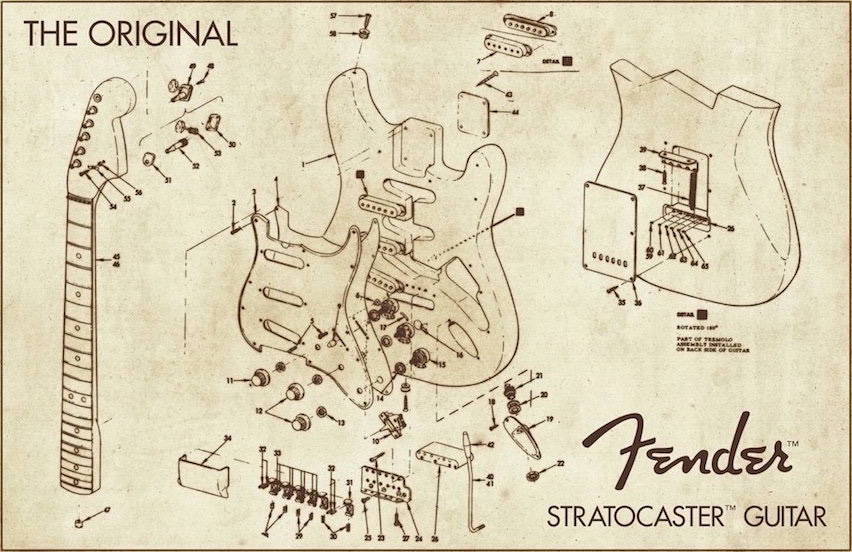
1954 Fender Stratocaster: The Birth of an Icon
The Strat body featured a two-horned cutaway, rounded edges and contoured body. It was made of ash, which is known to have a nice twang and a good sustain.
To give the guitar a more high end look, Fender sales chief Don Randall insisted on a sunburst finish: a brownish-black outer hue called dark Salem, which graduated to a golden inner hue called canary yellow.
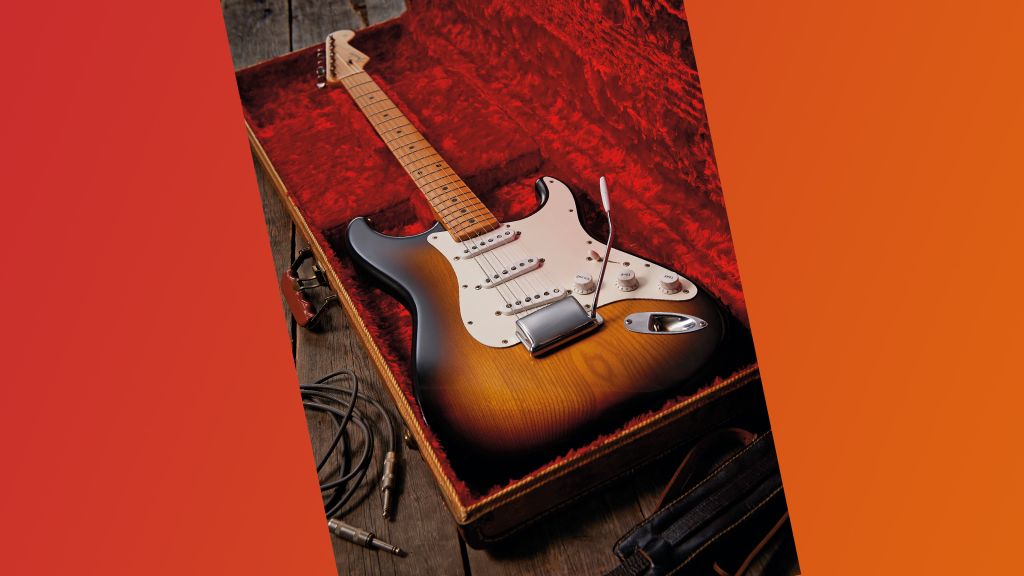
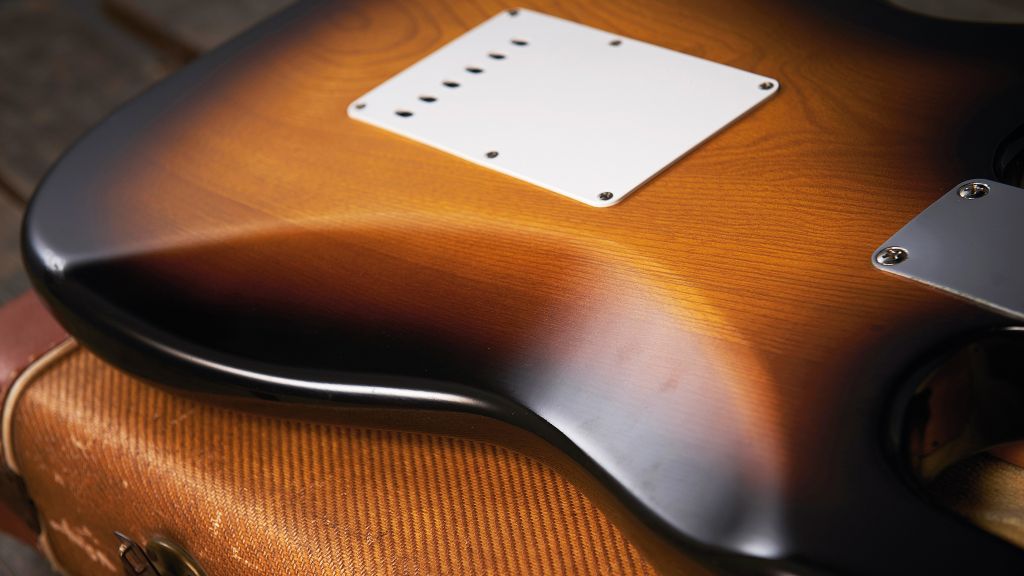
The U-shaped neck was made of a single piece of maple with black dot position markers. The walnut “skunk strip” ran down on the back of the neck where truss rod was installed. The fingerboard had a 7.25” fingerboard radius with small (.078” wide) frets.

The headstock was influence by instruments built by Paul Bigsby.
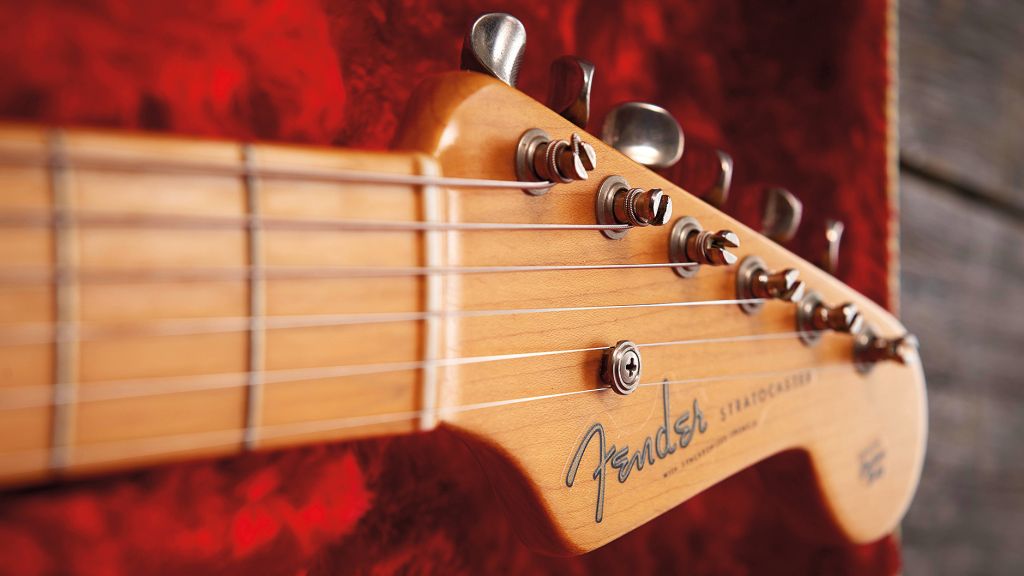

Stratocaster introduced the single-coil alnico triple-pickup configuration. Electronics were mounted to the single-ply white plastic pickguard (anodized aluminum on some early models) rather than to the body, enabling an entire pickguard/pickups/controls assembly to be dropped in place and screwed on (using eight screws) and only requiring connection to the output jack. The three control knobs placed near the bridge were within easy reach of the strumming/picking hand—a master volume and two tone controls for the neck and middle pickups.
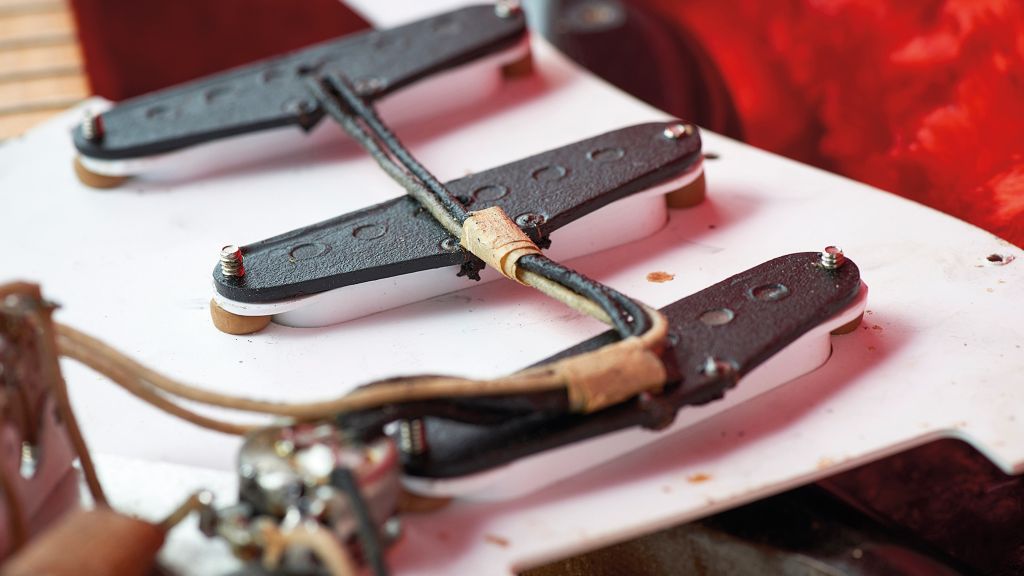
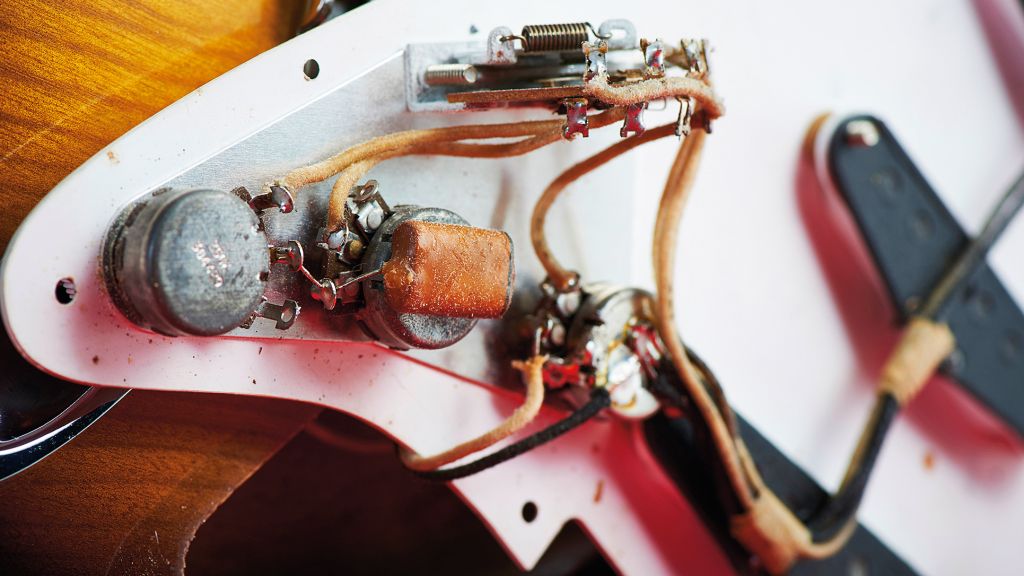
The bridge is Strat’s biggest innovation. Leo Fender designed a brand new vibrado system. The initial design is not a success, used a bridge with rollers for each string and a separate tailpiece. In this design, the strings actually moved over the bridge on the rollers. a steel two-piece unit with six saddles that could be adjusted for intonation and height.
The new design the whole bridge assembly moved with the strings rather than having the strings move over rollers with the bridge remaining stationary.
There are three major parts: a tremolo bar, a bridge plate, and an adjustable anchor plate. The tremolo bar is inserted into the bridge. The rear of the bridge plate is unanchored and bent slightly upward; the front was fixed to the guitar body with six screws, one in front of each bridge saddle. The entire bridge could be rocked back and forth using an easily detachable “tremolo” arm, thus raising and lowering pitch. The anchor plate is placed inside the back compartment and screwed to the forward wall of the cavity. The bridge is attached to the anchor plate by three to five springs.
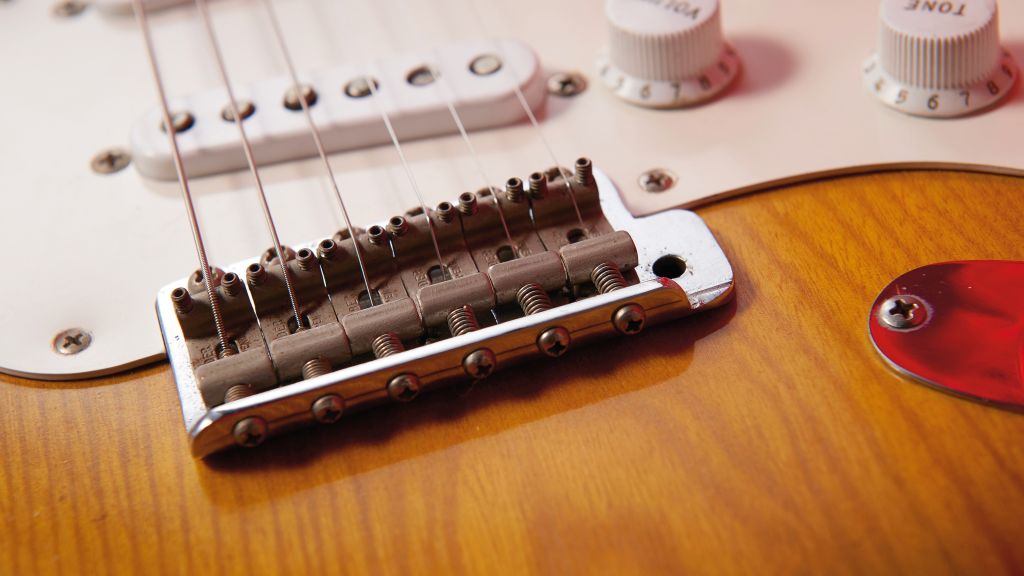

Some other interesting notes about the original production Strat: a slanting output jack mounted on the face of the guitar rather than the side. Serial numbers, originally located on the back tremolo plate, were moved to the neck plate in early summer 1954. Fender was using polystyrene based plastics for their guitars, which is commonly nicknamed bakelite (pronounced Bake-A-Lite). It was very brittle, and would wear down and crumble apart quite easily (not sure if it’s 1954).
Specs
- Body: Ash
- Finish: Two-color sunburst
- Neck: Maple, ‘U’-shaped (‘D’-shaped), 7.25” radius fingerboard
- Pickup: 3 single coil, 3-way switch
1955 Fender Stratocaster
There were not significant changes happening to Strat besides slightly refinements. The production process was improved, leading to a lighter weight. Serial number, located in the back metal neck plate, generally ranges from 6000 to 9000,
The brittle plastic originally used for Stratocaster pickguards, control knobs and pickup covers was replaced with a more durable plastic in 1955.
The round string holes in the rear tremolo plate became oval-shaped in mid 1955.
Specs
- Body: Ash
- Finish: Two-tone sunburst
- Neck: Maple, ‘U’-shaped (‘D’-shaped), 7.25” radius fingerboard
- Pickup: 3 single coil, 3-way switch
1956 Fender Stratocaster
1956 Fender Stratocaster serial numbers generally run from 9000 to 16000 (stamped on the neck plate).
Fender switched from ash to less-expensive and more easily workable alder for sunburst Stratocaster bodies in mid 1956 (blond Strats still use Ash). The finish process also changed: the yellow/amber tint for the sunburst finish started to be dyed into the wood, as opposed to being sprayed, making the process more efficient and economical. Then an outer edge was sprayed to create the burst.
The headstock’s round string retainer was switched to the “butterfly” string tree with a “half-tunnel” guide for the B and high E strings.

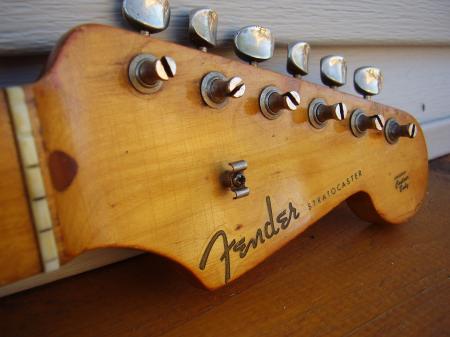
In mid 1956, the tuners were switched from the Kluson “no-line” tuners to the Kluson Deluxe “single-line” tuners (which feature “Kluson Deluxe” engraved in them in a vertical line).
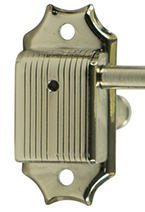

The original rounded ‘U’-shaped profile was changed to soft ‘V’ profiles.

Pickup magnets were changed from alnico 3 to alnico 5 in late 1956.
Specs
- Body: Ash => Alder
- Finish: two-tone sunburst
- Neck: Maple, soft ‘V’-shaped, 7.25” radius fingerboard
- Pickup: 3 single coil, 3-way switch
1957 Fender Stratocaster
The 1957 Fender Stratocaster is considered a “classic” year by most with its two-tone sunburst finish on an Alder body wood with a Maple “V” neck. Serial number range for the 57 Fender Stratocaster are generally 16000 to 25000 (some numbers with a “0” or “-“ prefix on the neck plate).
Most 1957 Strats have a neck with a strong “V” backshape.
The plastics for a Stratocaster includes the volume and tone knobs, the pickup selector tip, the pickup covers, and the pickguard. Fender started using ABS plastic instead of polystyrene, which is more resistant and does not crumble like a cracker in mid 1957.
George Fullerton created what is now referred to as the first “official” Fender custom color—the Fiesta Red—circa 1957.
1958 Fender Stratocaster
The 1958 Fender Stratocaster saw some major changes take place. The serial number range for the 58 Fender Stratocaster’s are generally from 25000 to 30000 (some numbers start with a “0” or “-” prefix on the neck plate).
The ‘V’-shaped profile was changed back to ‘D’-shaped neck (thin ‘U’-shaped neck).
The two-color sunburst finish became a three-color sunburst finish in the first half of 1958 with the addition of an “in between” red hue.
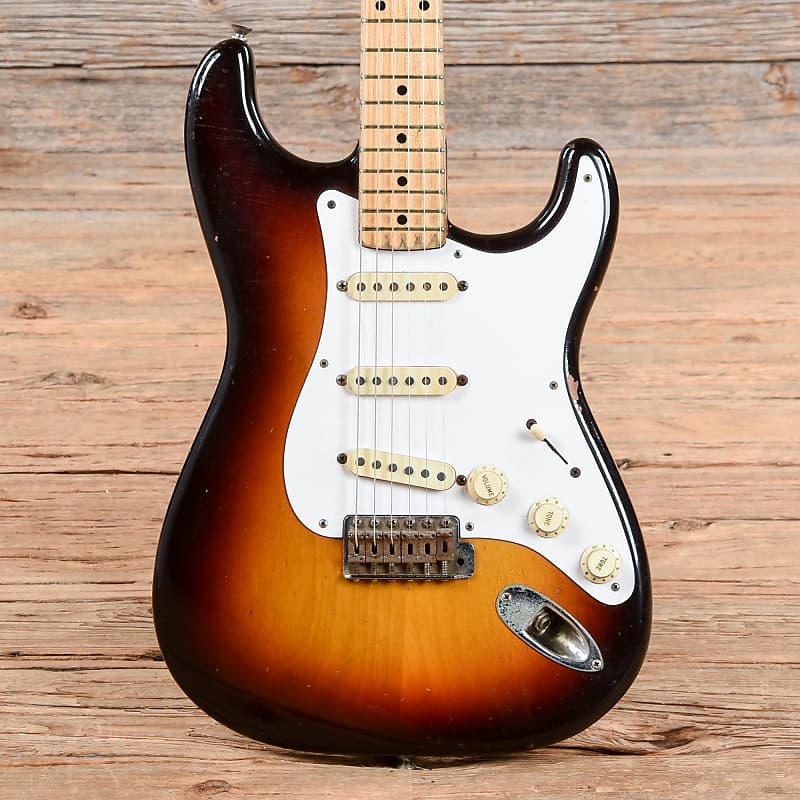
1959 Fender Stratocaster
The serial number range for the 59 Fender Stratocaster are generally 30000 to 40000.
The one-piece neck-fingerboard was replaced by a two-piece construction consisting of a rosewood “slab” fingerboard (so nicknamed later on for its thickness and flat bottom) glued atop the maple neck with white “clay” position dots. This change is implemented for the summer 1959 NAMM show. Basically Strats 5/59 and later will have rosewood fingerboards.
The neck has a very thin “D” backshape. As 1959 progresses, the neck backshape gets even thinner.
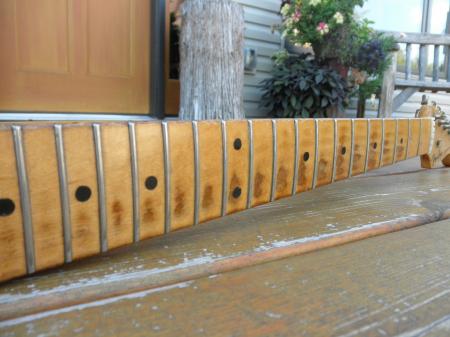
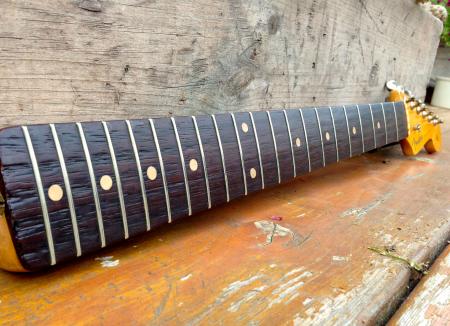
The ‘skunk stripes’ became unnecessary because the truss rods channels on those instruments were routed into the front of the neck rather than the back, and then covered by the glued-on fingerboards.
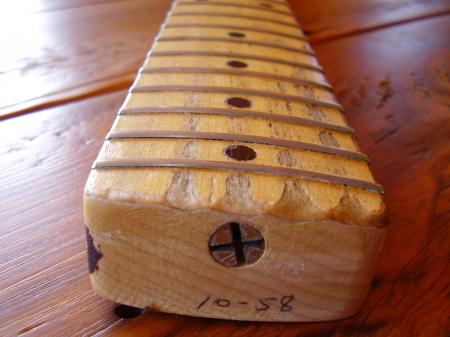
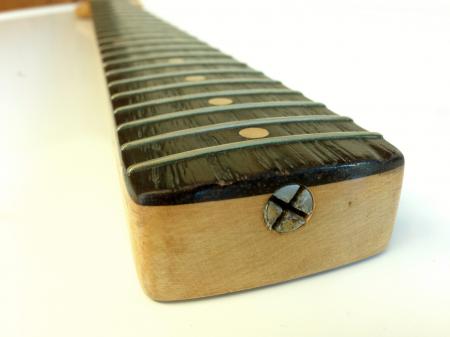
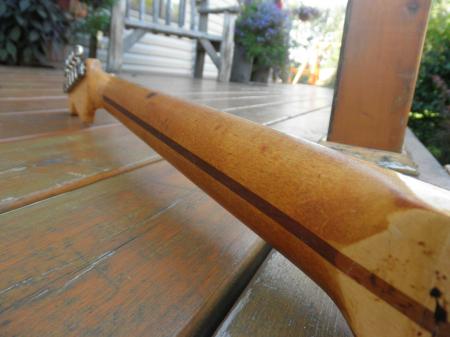

These new rosewood-fingerboard models also replaced the black marker dots on the side of the neck with new off-white “clay” dots.
Fender used a red dye that was very reactive to UV light in the sunburst finish, causing it to fade, so your 3-color sunburst guitar suddenly became a 2-color sunburst
The single-ply white pickguard was replaced by multi-ply white-black-white celluloid pickguard with more screw holes (11) and a notable greenish tint. This celluloid pickguard was implemented around 7/59.
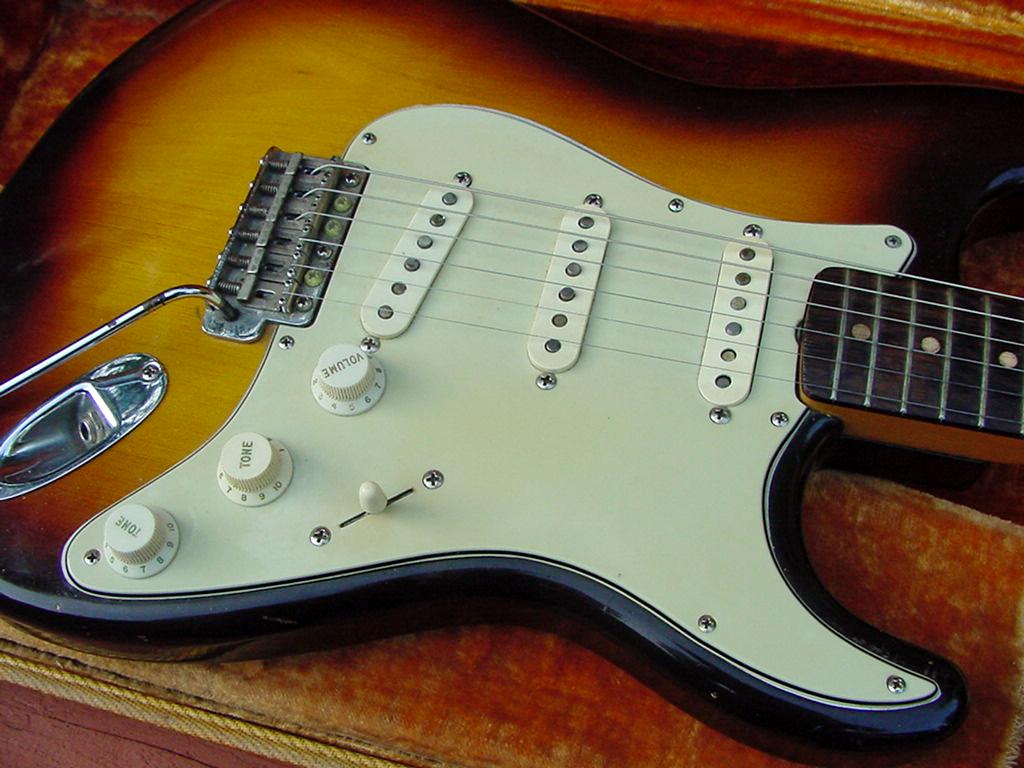

1960 Fender Stratocaster
The serial numbers for the 1960 Stratocasters generally fall within the 40,000 – 58,000 range stamped onto the neck plate. Not much changed from 1959 to 1960 but the guitar did become slightly more refined in the changes that took place over the 1959 year models.
The biggest change for 1960 Strats is that Fender switched from North Wound Pickups to South Wound Pickups. North wound vs south wound pickups just relates to the position and polarity of the magnets used. There is no real difference in tone
1961 Fender Stratocaster
The serial number range for the 61 Fender Stratocaster are generally 55000 to 72000 (on the neck plate).
Fender now using a more robust red in their sunburst finish. Hence 1961 and later Strats don’t have sunburst finished with a faded out red. The dark “Amber brown” part of the sunburst finish is now changed to “black”. Hence the dark part of the sunburst is more striking and does not blend as well as prior sunburst finishes.
Fender also added the patent numbers to the peghead during 1961, the peghead decal logo now has 2 patent numbers (2,573,254 & 2,741,146)
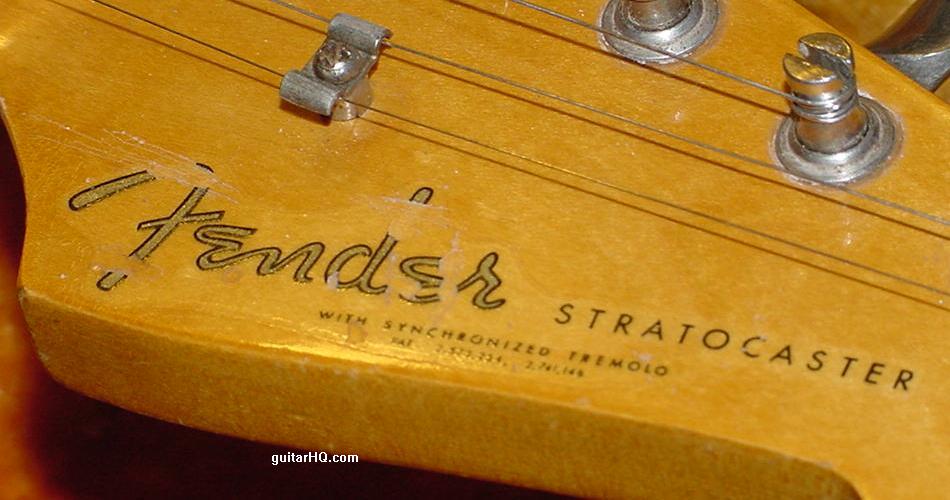
1962 Fender Stratocaster
The serial number range for the 62 Fender Stratocaster are generally 72000 to 93000 (on the neck plate).
One of the early changes is that the peghead decal logo now has 3 patent numbers (2,960,900 added).
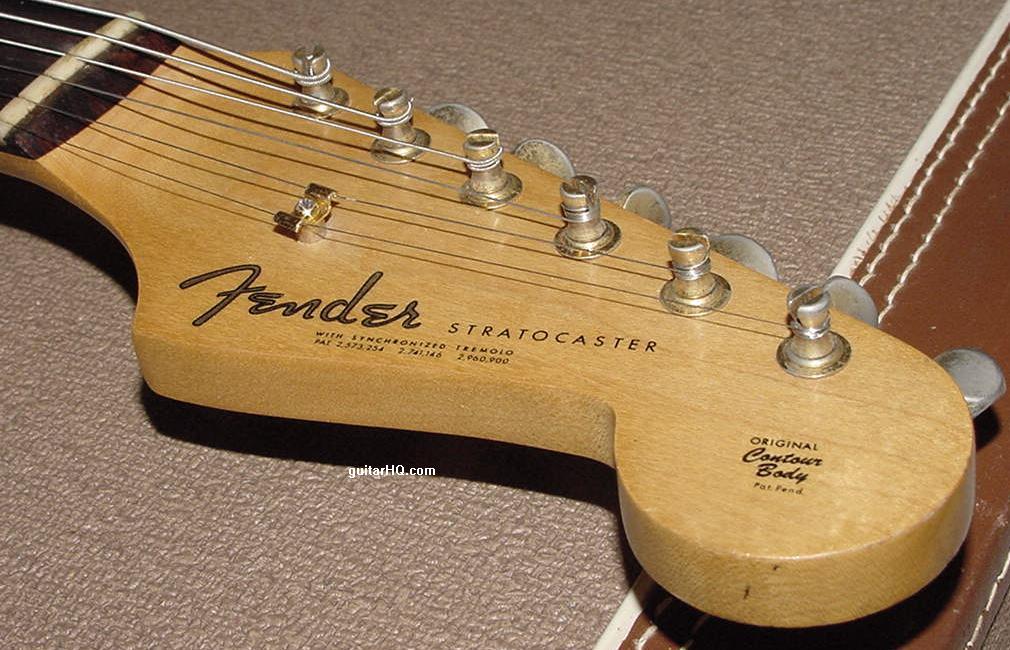
In March 1962 Fender changed from a hand-written neck date on the butt of the neck to a rubber stamped date. The neck width was also part of the stamp, most commonly the “B” width, where the “B” signifies a 1 5/8” nut width. More rare necks include an A width which was for the 1 1/2″ nut width. There were also C width nuts which measured 1 3/4″ and a D width measured at 1 7/8″.
The biggest change is that Fender switched from the thick “slab” rosewood fingerboard to a thinner “veneer” style. Previously, the bottom of the fingerboard is flat, it is now radiused like the top playing surface of the fingerboard, rendering the fingerboard much thinner. This changed the Strat’s sound a bit, making it less full and less warm.
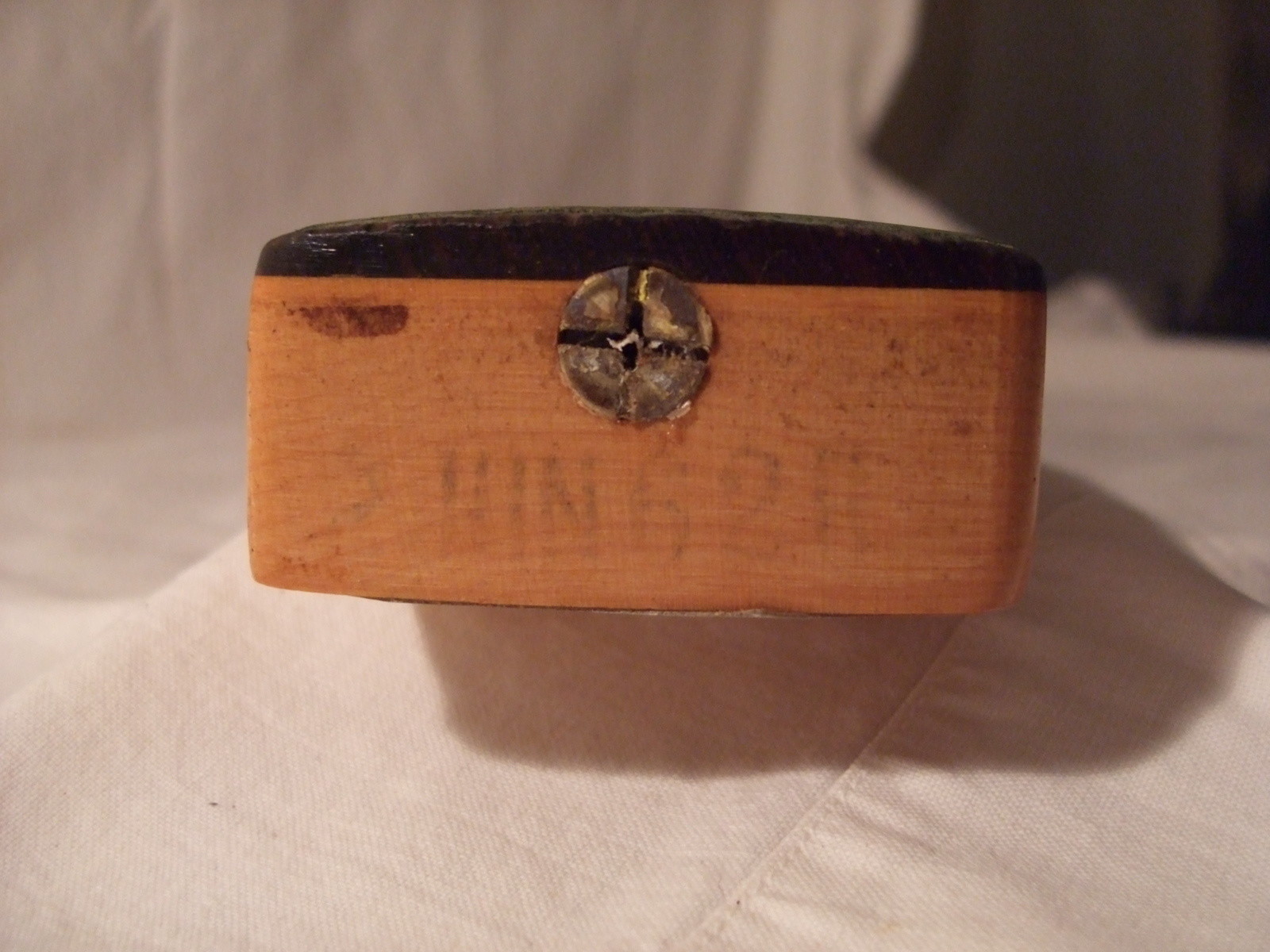
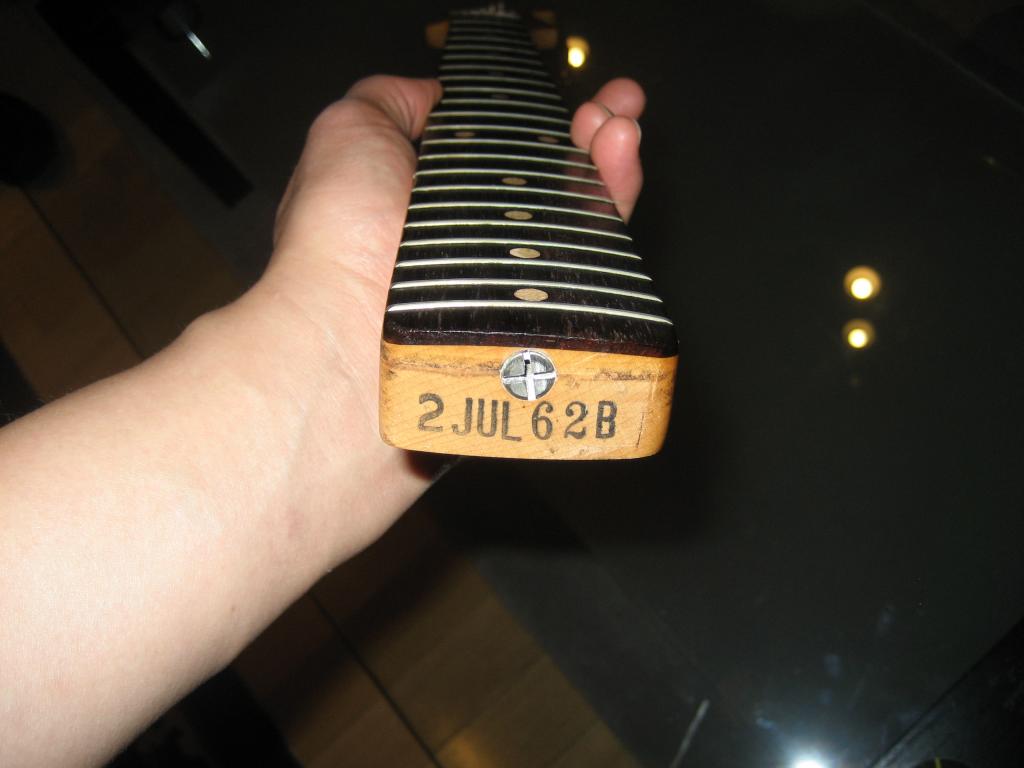
In late 1962, the paint process is also changed. Fender used a “stick” to hold the guitar in the neck pocket while painting the Stratocaster, so the neck pocket is not entirely painted.

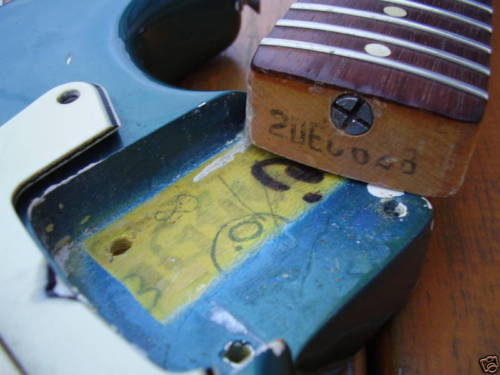
1963 Fender Stratocaster
The serial number range for the 63 Fender Strat runs from 93000 to 99999 in the early part of the year. Then, in the spring of 63 Fender introduced the L series serial numbers. They started with L00001 and roughly go up to L20000.
1963 did not bring any huge change to the Fender Stratocaster (compared to late 1962 models). The one subtle change is the location of the pickguard screw between the neck and middle pickup is moved about 1/2” towards the middle pickup.
Another subtle change was the stamping of “Fender Pat. Pend” being slightly more pronounced on the bridge saddles.
1964 Fender Stratocaster
The serial number range for the 64 Fender Stratocaster are generally L20000 to L55000 (on the neck plate).
By mid-1964, the peghead “Fender” logo changed from the small and thin “spaghetti” logo to a more bold “transition” logo. It also has an added 4th patent number 3,143,028 as well.
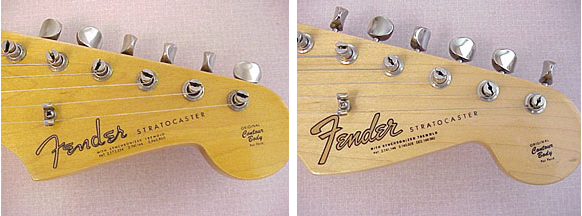
The finishing procedure also changed for the Stratocaster at about the same time, allowing Fender to use more pieces of woods and body wood of lesser visual quality.
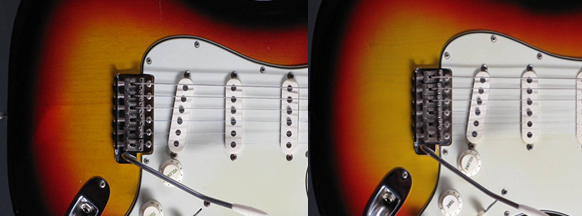
By the fall of 1964 “clay” fingerboard dots were changed to Pearloid (a plastic that looks like pearl).
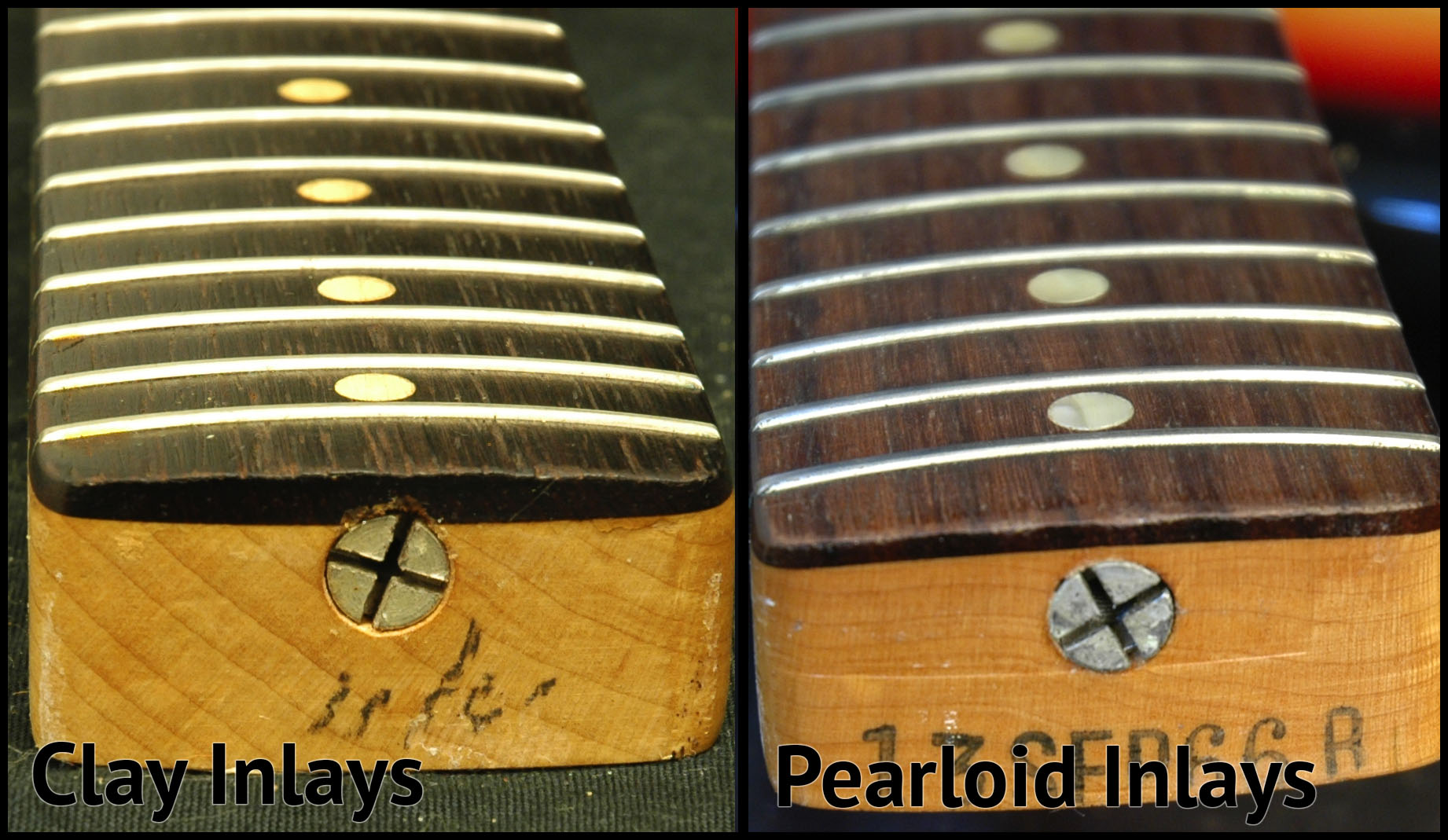
Late 1964/early 1965 brought a change in pickguard material from the mint-green celluloid to a more stark white ABS plastic.
Other notable changes to the 1964 Fender Stratocaster were the tuning keys. They had been using “single line” Kluson tuners since around 1956. Toward the end of 64, the Stratocaster switched to a “double line” Kluson tuner.
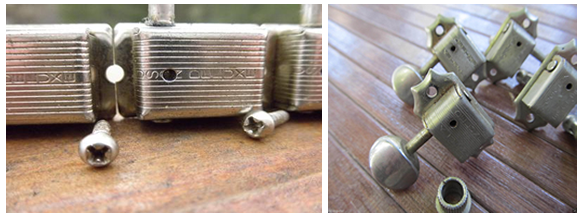
Since it’s inception the Stratocaster had been using the black bottom single coil pickups. Around the spring to early summer, they started stamping the bottom of the pickups with a yellow date on the bottom showing when it was wound. As they moved through the year of 1964 they transitioned to a gray bottom pickup.

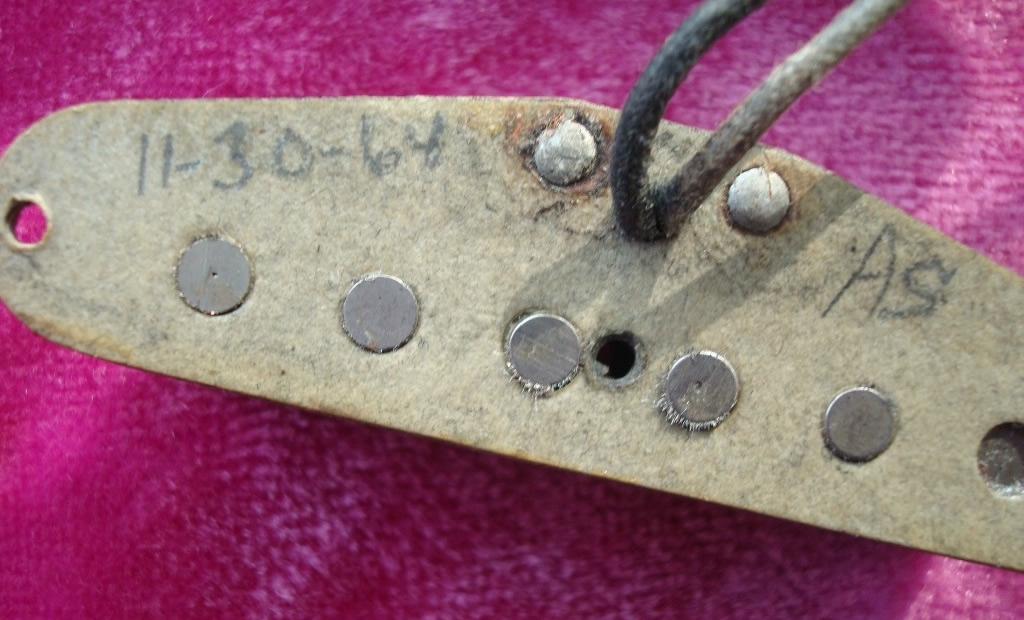
Guitar Heros
Jimi Hendrix

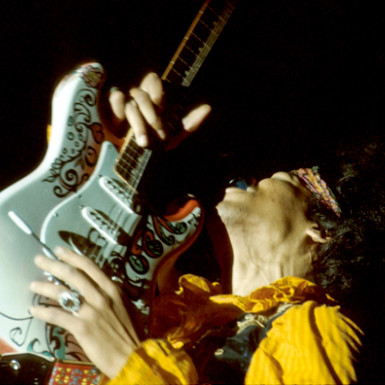
Eric Clapton


George Harrison

David Gilmour

Stevie Ray Vaughan
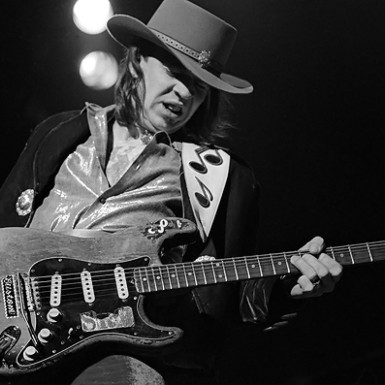
John Mayer


My first Strat: Maple
I don’t name my guitars unless I’m certain that I will keep them for the rest of my life just in case I wouldn’t get attached to them. My very first Strat is a Mexico-made Fender Player Strat, and she is Maple.
References
Leo Fender’s
patents
Pitch Control: A Tremolo
Primer
1954 Fender Stratocaster Guitar
Under the microscope: Fender 1954 Stratocaster
The stories behind eight ridiculously famous
Stratocasters
Pre CBS Stratocaster
Legendary Guitars